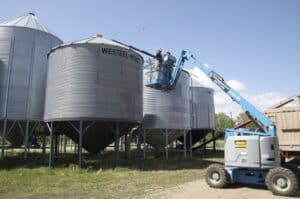
Whether you’re waiting to get into the field or already cutting your crop, having a proper storage facility is critical. If you had last year’s grain in your bins for longer than usual, and into the spring when grain temperatures were no longer cold enough over specific durations to kill most insects, you may want to confirm your storage locations are ready for this year’s crop.
This means ensuring bins are clean and free of mold, dust (which could harbor insect eggs), insects and rodents. It also requires getting rid of any unused treated seed (which contains pesticides) and animal protein (blood meal or bone meal). Doing this helps to ensure your canola seed will be ready for export.
Any leftover grain, debris or dockage (especially if this includes other grains) can be a food source to insects, such as the merchant grain beetle, the rusty grain beetle, the red flour beetle and the saw-toothed grain beetle. Clean out the bin with high-pressure water or air and a heavy broom or vacuum, remembering to clean the aeration systems as well, including ducts, and exhaust systems. If possible, clean out augers too, as they can harbor insects. If needed, the bin can be treated with a registered diatomaceous earth product, but not malathion (unless used over six months before grain is stored in the bin). To further prevent insects in other stages from developing near storage facilities, reduce or remove vegetation within 10 m of the storage sites.
Remaining seeds can also act as a substrate for storage molds or fungi, and species of molds will flourish at different temperatures relative humidities, with higher moisture levels allowing more aggressive molds to grow. Soil and decaying plant material can house spores, as well as mites, which carry the mold spores. If you have a heavy contamination of certain mite species, you may notice a distinctly minty odor in your bins.
Larger piles of leftover grain can also attract rodents, which will leave behind droppings. Although the risk is low, a few recent cases of people getting the Hantavirus highlight the importance of wearing proper protective equipment. This includes wearing gloves, covered shoes and a mask, since the virus is transmitted through breathing in airborne particles or being bitten by infected rodents.
To read recent research on best management practices for summer storage of canola, check out Joy Agnew’s PAMI project, supported by the Canola Council of Canada. Read Joy’s updates on the bin conditions throughout the season and keeping grain in ideal conditions.
For more information on storage management, check out the Canola Encyclopedia.
